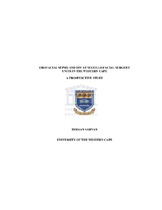| dc.description.abstract | The World Health Organisation estimated that in 2002 more than 13,772 000
deaths in developing countries were caused by infections. This accounted for more than 45% of all deaths, making up 7 of the top 10 causes of death (World Health Organisation, 2004). Sub-Saharan Africa is the epicentre of the devastating HIV pandemic. The country leading with the highest HIV rate in the world is South Africa, with approximately 5.5 million people infected(UNAIDS, 2008; South Africa Country Progress Report, 2008).The development from HIV to AIDS progressively weakens the immune system, making the individual more susceptible to numerous infections, e.g.various forms of orofacial sepsis (Mindel, and Tenant-Flowers, 2001). HIVpositive individuals are eighteen times more likely to become infected with community-acquired methicillin-resistant Staphylococcus aureus than the
general population. (Crum-Cianflone et al., 2006). The management of sepsis
is of great concern with regard to human morbidity and mortality, as well as its financial implications, especially in cases of antibiotic resistance (Kimleck et al., 1976; Panlilo et al., 1992; Kirkland et al., 1999). Currently, there is no published peer-reviewed literature assessing the impact of HIV on orofacial sepsis. This study aimed to assess the impact of HIV on orofacial sepsis, investigating the clinical and microbiological profiles of the population. These results were used as a guide in the adaptation of current treatment protocols.The study population consisted of patients with orofacial sepsis (requiring incision and drainage or admission) who were referred to the Maxillo-Facial and Oral Surgery Units at either Groote Schuur or Tygerberg Hospitals. These patients were examined, diagnosed and treated as per standard protocol. The empiric antibiotic treatment was tailored according to microscopy and sensitivity results when it became available. The exclusion criteria of the study were refusal of HIV testing or unwillingness of patients to participate in the study.The ratio of HIV positive patients treated was much higher than the population prevalence (2.4:1.1). Odontogenic infections (71.11%), followed by septic jaw fractures (15.56%) were the most common causes of sepsis. The most common causative teeth were the mandibular posterior teeth (43.75%)(excluding the mandibular 3rd molars). The most common fascial spaces involved in the HIV positive group were the submandibular spaces (36%),followed by the submasseteric and canine spaces (27% each). In the HIV negative group, the buccal (41%) and submandibular spaces (33%) were the most common fascial spaces infected.The HIV negative group had the most multi-fascial space involvement, with 35% having more than one fascial space involved. In comparison, the HIV positive group had only 18% involvement of more than one fascial space. This was also reflected by the HIV negative group, which included five cases of Ludwig’s Angina as compared to one case in the HIV positive group. The Gram Stain showed a predominance of Gram positive cocci for both the HIV positive and negative groups. Gram positive bacilli were significantly more prevalent in the HIV negative group (p = 0.0409). Pre-treatment antibiotics were associated with sterile abscesses in 20% of the cases. No growth on culture occurred only in the HIV negative group (statistically significant with p = 0.00488).A statistically significant increased length of admission was found for the cases with penicillin-resistant bacteria (Wicoxin Rank Sum Test p =0.0072). Penicillin resistance was found in 17.78% (8 cases) with ten strains of five types of bacteria (S. aureus, K. pneumonia, Enterobacter, E. coli,Alpha-haemolytic Streptococcus). Eight percent (5) of these cases were also resistant to co-amoxiclav®.In the HIV positive group the following trends (p>0.005) were found:• The average platelet counts of this group was 112.34 x108/L (lower than the HIV negative group);• The length of admission for the HIV positive group was slightly longer by 0.25 days even though this group had fewer fascial spaces infected;• A larger number of bacteria with penicillin-resistance was more prevalent in the HIV positive group (six resistant bacteria in four cases compared to four resistant bacteria in four cases).Greater numbers of orofacial infections were seen in HIV positive subjects relative to their population prevalence rates. Added to this, was the higher rate of antibiotic resistance and longer hospital admissions.These findings may warrant further investigation of the relationship
between HIV positive and negative groups with regard to orofacial sepsis. | en_US |

